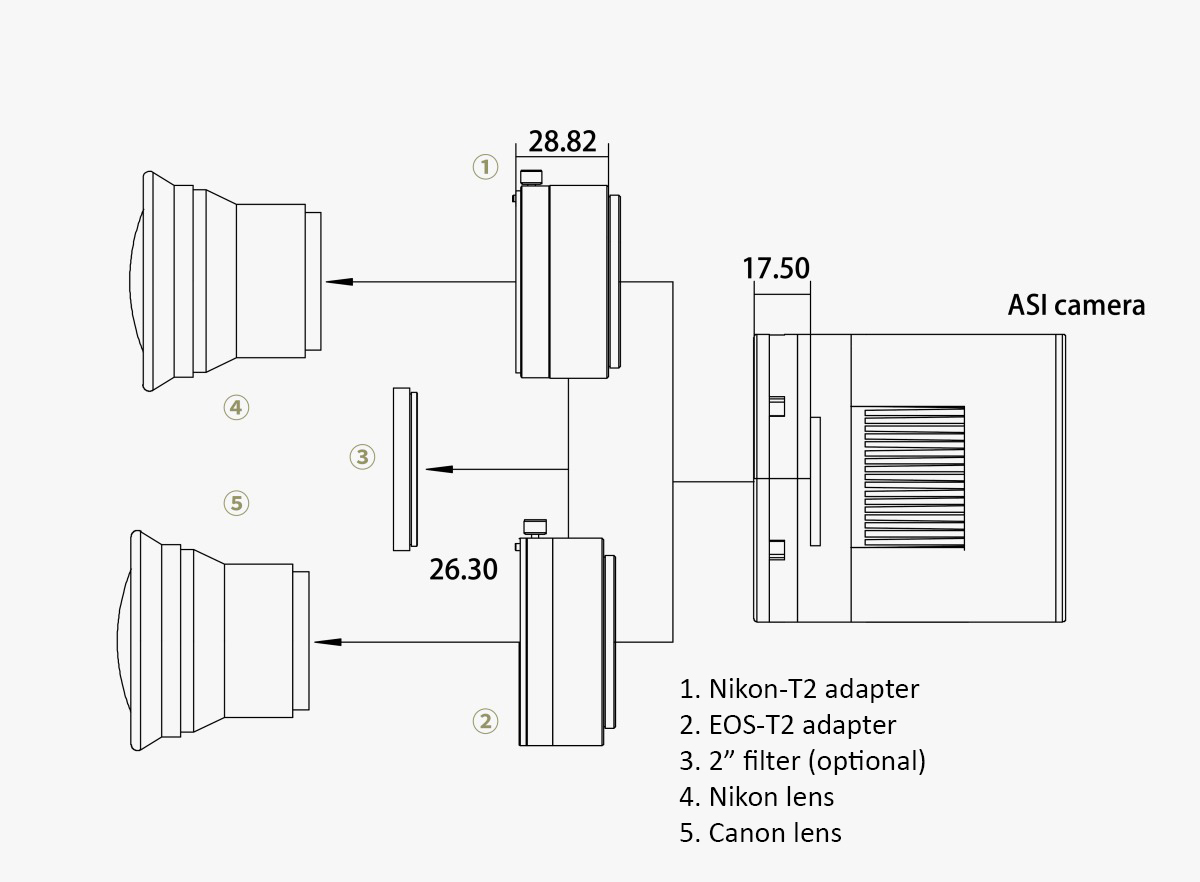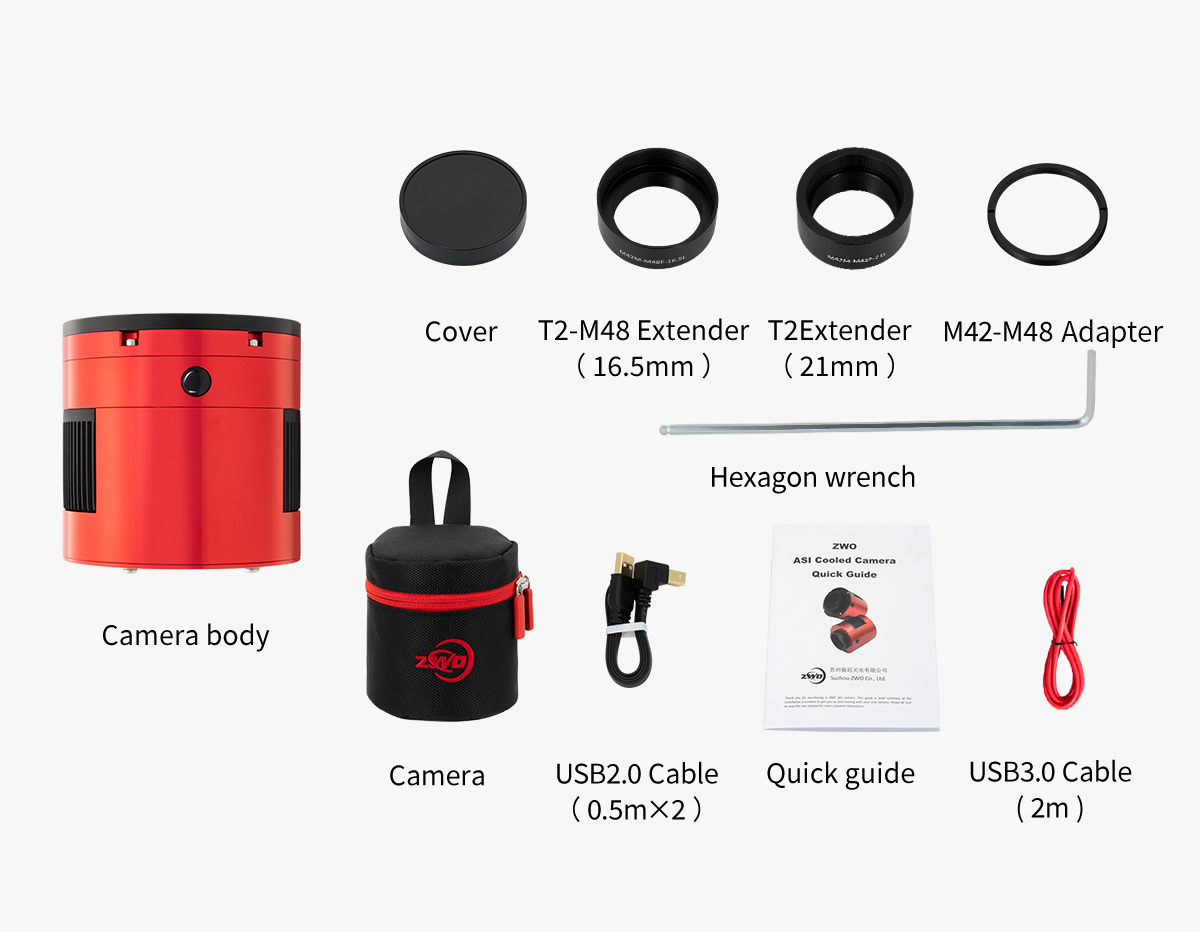ASI2600MMP
ZWO ASI2600MM-Pro APS-C mono Kamera
Die ASI2600 mono zeichnet sich durch ein rauscharmes Bild und das Fehlen von Ampglow aus!
Die ASI2600MM Pro verwendet den neuesten rückseitig beleuchteten IMX571 APS-C-Format-nativen 16-Bit-ADC-Sensor von Sony. Sie ist eine der am meisten erwarteten Astronomie-Kameras des Jahres 2021. Hier sind einige der Gründe dafür:
Ultrahoher Dynamikumfang von 14 Blendenstufen
Ultra-niedriges Ausleserauschen von 1,0e
Innovatives, bahnbrechendes Design ohne Ampglow
16-Bit-ADC-Sensor
Wie die Farbversion ist auch die ASI2600MM Pro mit nur 700 Gramm sehr leicht.
APS-C-Format:
Diese 26-MP-Kamera verfügt über eine kleine Pixelgröße von 3,76 µm und bietet dennoch eine unglaubliche Well Depth von 50 ke.
Die Länge und Breite des Sensors betragen 23,5 mm * 15,7 mm. Die Diagonale beträgt 28,3 mm.
Nativer 16-Bit-ADC:
Als eine der wenigen CMOS-Astronomie-Kameras mit 16-Bit-ADC auf dem Markt wurde die ASI2600MM Pro mit Blick auf die optimalen Eigenschaften für die Astrofotografie konzipiert. Dieser 16-Bit-ADC ist kein CCD-16-Bit-ADC. Er erreicht tatsächlich einen Dynamikbereich von 14 Blendenstufen, was die Bildschärfe und den Kontrast deutlich verbessert und für weichere und natürlichere Kontrastübergänge sorgt (sowie für Farbverläufe bei Verwendung verschiedener Filtertypen).
IMX571-Sensor mit Hintergrundbeleuchtung:
Der rückseitig beleuchtete CMOS-Bildsensor von Sony verbessert die Empfindlichkeit und Rauschunterdrückung – die wichtigsten Faktoren für eine bessere Bildqualität. Dies wird durch eine radikale Neuausrichtung der grundlegenden Pixelstruktur von Frontbeleuchtung auf Rückbeleuchtung erreicht, wobei die Vorteile von CMOS-Bildsensoren wie geringer Stromverbrauch und hohe Geschwindigkeit erhalten bleiben.
Bei einer herkömmlichen Frontbeleuchtungsstruktur behindern die Metallverdrahtung und die Transistoren auf der Oberfläche des Siliziumsubstrats, die den lichtempfindlichen Bereich (Fotodiode) des Sensors bilden, die Lichtaufnahme durch die On-Chip-Linse. Eine rückbeleuchtete Struktur minimiert die Verschlechterung der Empfindlichkeit gegenüber dem optischen Winkel und erhöht gleichzeitig die Lichtmenge, die in jedes Pixel eintritt, da keine Hindernisse wie Metallverdrahtungen und Transistoren vorhanden sind. Diese Komponenten wurden auf die Rückseite des Siliziumsubstrats verlegt.
Kamera-Leistung:
Die ASI2600MM Pro bietet eine hervorragende Leistung mit einem Dynamikbereich von bis zu 14 Blendenstufen. Wenn der Verstärkungswert auf 100 eingestellt ist, wird der HCG-Modus für hohe Verstärkung aktiviert. Wir behaupten nicht, dass es sich um Zauberei handelt ... aber wir glauben, dass es dem ziemlich nahe kommt. Bei aktiviertem HCG-Modus wird das Ausleserauschen erheblich reduziert, und der Dynamikbereich bleibt im Wesentlichen unverändert. Um die Datenqualität zu verbessern, wird empfohlen, die Verstärkung bei Deep-Sky-Aufnahmen auf 0 oder 100 einzustellen.
Zero Amp Glow:
Herkömmliche CMOS-Sensoren erzeugen während des Betriebs häufig eine schwache Infrarotlichtquelle, die in den Ecken unkalibrierter Bilder zu sehen ist. Dies ist ein deutliches Anzeichen für „Amp Glow“. Da die ASI2600MM Pro über eine Zero Amp Glow-Schaltung verfügt, müssen Sie sich auch bei Aufnahmen mit hoher Verstärkung und langer Belichtungszeit keine Gedanken über Amp Glow machen.
Anti-Tau-Heizung:
Die ASI2600MM Pro Kamera verfügt über eine Polyimid-Heizung, die vollständig in das Schutzfenster passt. Sie hilft, je nach Aufnahmeumgebung lästige Probleme durch Tau oder Vereisung zu vermeiden.
Die Leistung der Heizung beträgt etwa 5 W. Sie können sie jederzeit in Ihrer Fotosoftware ausschalten, wenn Sie Strom sparen möchten.
QE-Wert:
Laut den Testergebnissen von Sony beträgt der QE-Spitzenwert der ASI2600MM Pro 91 %.
Zweistufige TEC-Kühlung, extrem niedriger Dunkelstrom:
Dank der zweistufigen TEC-Kühlung kann die ASI2600MM Pro die Temperatur des CMOS-Sensors um mehr als 35 Grad Celsius unter die Umgebungstemperatur senken, wodurch die Dunkelstromerzeugung und das Sensorrauschen auch bei längeren Belichtungszeiten erheblich reduziert werden.
*Der Delta T-Wert von 35 °C wurde bei einer Umgebungstemperatur von 30 °C gemessen. Bei längerem Betrieb des Kühlsystems kann er sinken. Außerdem nimmt der Delta T-Wert mit sinkender Umgebungstemperatur ab.
Die einzigartige Technologie zur Unterdrückung des Dunkelstroms kann das Dunkelstromrauschen weiter reduzieren. Bei einer Kühltemperatur von 0 °C beträgt das Dunkelstromrauschen nur 0,0022e/s/Pixel. Das bedeutet, dass eine Belichtung von 300 s nur 0,7e Dunkelstromrauschen verursacht, was weniger als das Ausleserauschen ist. Bei einer Kühltemperatur von -20 °C kann der Dunkelstrom sogar auf 0,00012e/s/Pixel reduziert werden, was völlig vernachlässigbar ist!
Bitte beachten Sie, dass die Kamera an eine externe 11-15-V-Stromversorgung angeschlossen werden muss, um die Kühlfunktion nutzen zu können. Wir empfehlen die Verwendung eines 12-V-DC-Adapters (5,5 × 2,1 mm, Mittelpol positiv) oder einer Lithiumbatterie mit 11-15 V zur Stromversorgung der Kamera.

